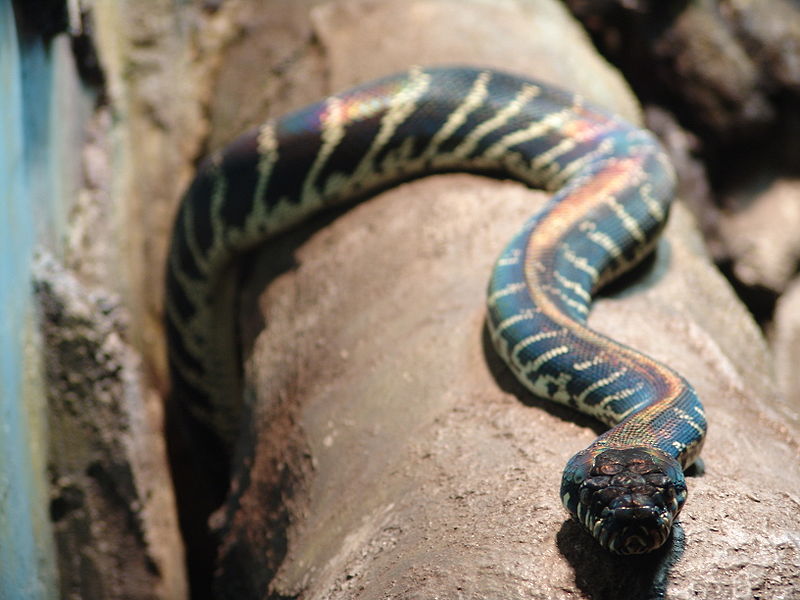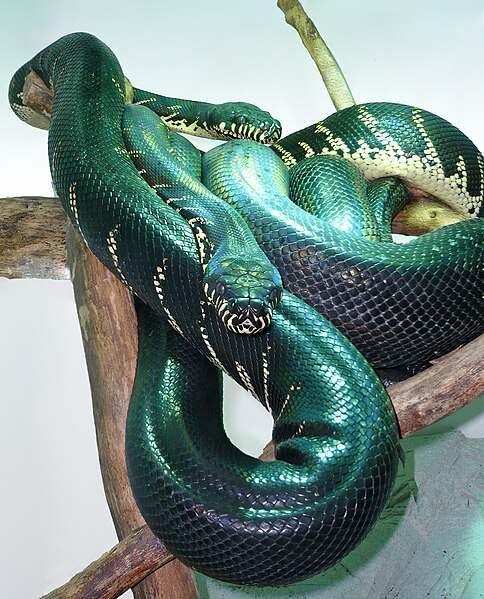 This article is one of a series in which I plan to provide a brief introduction to both popular and rarely-kept amphibians, reptiles and invertebrates. Detailed care articles will follow…until then, I would enjoy receiving your questions and comments. Today we’ll take a look at one of the world’s most stunning large constrictors, the Boelen’s or Black Python, Morelia boeleni.
This article is one of a series in which I plan to provide a brief introduction to both popular and rarely-kept amphibians, reptiles and invertebrates. Detailed care articles will follow…until then, I would enjoy receiving your questions and comments. Today we’ll take a look at one of the world’s most stunning large constrictors, the Boelen’s or Black Python, Morelia boeleni.
Recently, while thumbing through my well-used copy of Dick Bartlett’s wonderful book In Search of Reptiles and Amphibians (E J Brill, 1987), I came across his account of one of the first Boelen’s Pythons to be exhibited in the USA. It put me in mind of my early experiences with these awe-inspiring snakes, and I decided to look into their current status. I was happy to see that some great work has been done in both the field and captivity…a fantastic summary of this, along with many photos, is posted on the website of the Boelen’s Python Group.
Arrival in the USA
I began working with Boelen’s Pythons at the Bronx Zoo in the late 1980’s, when a group of wild-caught adults was confiscated and sent to us for safe-keeping; not many had been imported prior to this. Their iridescent, jet black bodies, capped by a broad head boldly marked in bright yellow-white, were a sight to behold.
Just as impressive was their ferocity…and at 8-10 feet long, they were a force to be reckoned with. While some folks do manage to handle Boelen’s Pythons with ease, many report that young and old alike retain personalities reminiscent of their oft-ill tempered relative, the Amethystine Python, M. amethistina.
Health Problems and Stress
Those I cared for did not adjust well to captivity. Stress had worsened the effect of their parasite load, and some of the worms and other nasties they harbored were difficult to eradicate.
When cleared of parasites, they proved too high strung for public exhibits. Those unable to retreat to the tops of trees, well out of view, struck at the glass and injured their snouts. They also tended to poke about for escape routes, lodging substrate along their gums and cutting themselves up in the process (this is a common problem). Several refused to descend from the trees to drink…these were given water-injected rats for a time.
Diet
 When it comes to feeding, wild-caught specimens often prove as fussy as the notoriously picky Green Anaconda (one Anaconda under my care took wild-caught but not lab rats, another refused all but Muskrats).
When it comes to feeding, wild-caught specimens often prove as fussy as the notoriously picky Green Anaconda (one Anaconda under my care took wild-caught but not lab rats, another refused all but Muskrats).
Bats, birds, lizards and marsupials such as phalangers and cuscus (please see photo) are taken by wild Boelen’s Pythons; captive bred rodents are often rejected. Some of mine favored guinea pigs; scenting rats with chickens and quails has also proven successful.
Natural History
Boelen’s Pythons, first described in 1952, are found only on New Guinea. They favor dense, humid rainforests, and are often associated with steep cliff faces. Arboreal activity has been reported, and captives certainly favor elevated resting sites, but subterranean retreats are also used (please see article below).
The Future
While some specimens have lived into their 20’s, captive breeding has been sporadic. That situation is changing, slowly, as we learn and experiment…please consider registering with the Boelen’s Python Group, and sharing your observations on this blog, if you are fortunate enough to work with these magnificent snakes.
Further Reading
Boelen’s Python care, natural history and photos
Boelen’s Python at Wilmington’s Serpentarium image referenced from wikipedia and originally posted by Danleo
Pair of Boelen’s Pythons image referenced from wikipedia and originally posted by tigerpython
 That Reptile Blog – Reptile, Amphibian and Exotic Pet Care and Information
That Reptile Blog – Reptile, Amphibian and Exotic Pet Care and Information



Hallo Frank
This, once again, interesting article has inspired me to share my experience in keeping an African rock python some time ago:
It was a juvenile (+/- 1.2mtr) that was caught in a residential area. I usually keep the snakes up to the time when we go camping some where in the wild and then I release them again.
Well, keeping the python was truly an AMAZING experience and one feeding session I would like to share:
We used to feed it birds and one day decided to watch.
So, as soon as the bird was put into its cage and flew around, the snake (as usual) slowly appeared from behind its rock to see what all the movement was about.
Upon realizing it was food, it immediately started stalking its prey!
It slowly…VERY slowly, approached the (by now relaxed) bird which was sitting on a branch. Interesting was that the bird was constantly turning its head toward the approaching python which then instantly stalled every muscle in its strikingly beautiful patterned body.
As soon as the bird turned its head back again….the approach continued and inch by inch the snake neared the bird from behind.
Stunned by this fascinating happening, me and my sons suddenly realized we where as much hypnotized by the snake as the bird was…!!!
Waiting for the python to strike, we were amazed as how near the bird let the snake come….Frank, later the python’s head was completely leaning against the bird…to such an extend that the head of the snake pressed the (by now sleeping) bird little to the front!! We were absolutely stunned and while gazing with amazement, we suddenly were “woken” by a loud squeak….and the bird was gone!
This was the second time (one time in natural environment) a have seen these sluggish appearing snakes, react soooo fast…almost invisible to the eye! And I do have great respect for these serpents!
Well, the end of the story (maybe not as fascinating as keeping the snake) was even more breath taking….it was upon releasing the snake….
Having had the privilege in observing this extraordinary beautiful python almost eye to eye, it was nothing in comparison when the snake “melted” back into nature……I WILL NEVER FORGET!
Hello Gert, Frank Indiviglio here.
Thanks for the great observations and kind words; it is quite amazing how well the camouflage works, isn’t it… I think many people who are used to seeing snakes’ gaudy patterns in books or bare exhibits do not realize how different all looks in the wild.
I too have seen birds allow very close approaches…as they depend largely upon sight and sound to detect danger, the snakes’ careful movements are very effective. Mammals may scent trouble, but also there is a “freezing” response that sometimes allows a close approach as well. I was interested in your observation that the snake froze each time the bird looked its way…snakes are far more perceptive than most imagine…their stalking is no less complicated than that of a cat or other mammal.
Good luck, enjoy and please keep me posted.
Best regards, Frank Indiviglio.
Stunning animal! but rarely seen among collectors.we need more cb animals.
Hello, Frank Indiviglio here.
Thanks for your interest in our blog. Yes, amazing; too bad they are p;roving harder than most to establish in captivity.
Please let me know if you need any further information. Good luck, enjoy and please keep me posted.
Best regards, Frank Indiviglio.